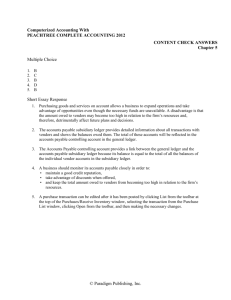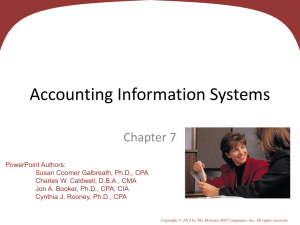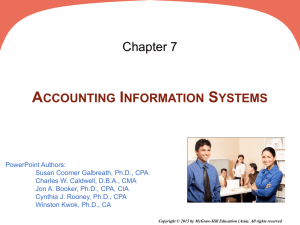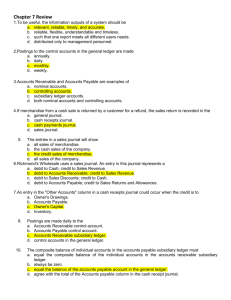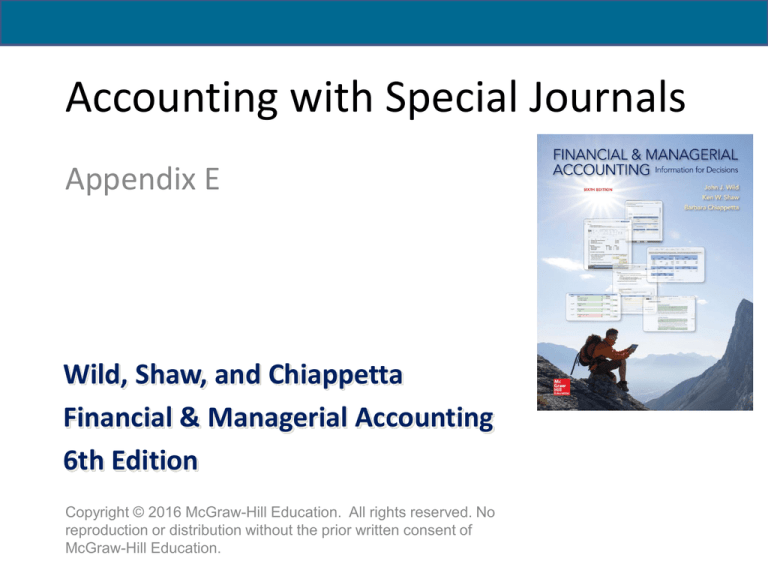
Accounting with Special Journals
Appendix E
Wild, Shaw, and Chiappetta
Financial & Managerial Accounting
6th Edition
Copyright © 2016 McGraw-Hill Education. All rights reserved. No
reproduction or distribution without the prior written consent of
McGraw-Hill Education.
E-C1: Fundamental System
Principles
2
7-3
Fundamental System Principles
Accounting
information
systems collect
and process data
from transactions
and events,
organize them in
useful reports,
and communicate
results to
decisions makers.
C1
3
7-4
Components of Accounting Systems
Increasingly, source documents are
electronic files creating a “paperless”
system.
C1
•Keyboards
•Scanners
•Modems
•Bar-Code Reader
•Hardware
•Software
•Professional Judgment
4
7-5
Components of Accounting Systems
•Printer
•Monitor
•Projectors
•Web communications
C1
•CD/DVD
•Hard Drive
•Tape
•Paper Document
5
NEED-TO-KNOW
Match each of the numbered descriptions with the principle, component, or descriptor that it best reflects.
Indicate your answer by entering the letter A through J in the blank provided.
A.
Control principle
F.
Source documents
B.
Relevance principle
G.
Input devices
C.
Compatibility principle
H.
Information processors
D.
Flexibility principle
I.
Information storage
E.
Cost-benefit principle
J.
Output devices
1.
2.
3.
4.
5.
6.
7.
8.
9.
10.
C1
J
I
H
G
F
E
D
C
B
A
Means to take information out of an accounting system and make it available to users.
Keeps data in a form accessible to information processors.
Systems that interpret, transform, and summarize information for use.
Capture information from source documents and enable its transfer to information processing.
Information for entries that can be in either paper or electronic form.
Prescribes that benefits from an activity in a system outweigh the costs.
Prescribes that a system be adaptable to changes in the company, environment, and user needs.
Prescribes that a system conform with a company’s activities, personnel, and structure.
Prescribes that a system report useful, understandable, timely, and pertinent information.
Prescribes that a system have internal controls.
6
E-C2: Special Journals in
Accounting
7
7-8
Special Journals in Accounting
C2
8
E-C3: Subsidiary Ledgers
9
7 - 10
Subsidiary Ledgers
Characteristic
Controlling
Account
Subsidiary Ledger
Amounts due
from customers
Accounts
Receivable
Accounts Receivable
Ledger
Amounts owed
to creditors
Accounts
Payable
Accounts Payable
Ledger
Subsidiary ledgers are a listing of individual
accounts with common characteristics.
C3
10
7 - 11
Accounts Receivable Ledger
After all items are posted, the balance in the accounts receivable controlling account is
equal to the sum of the balances in the accounts receivable subsidiary ledger.
C3
11
NEED-TO-KNOW
Match each of the numbered descriptions with the term, title, or phrase that it best reflects. Indicate your answer
by entering the letter A through J in the blank provided.
A. General journal
B. Special journal
C. Subsidiary ledger
1.
2.
3.
4.
5.
6.
7.
8.
9.
10.
C2/C3
J
I
H
G
F
E
D
C
B
A
D. Accounts receivable ledger
E. Accounts payable ledger
F. Controlling account
G. Sales journal
H. Cash receipts journal
I. Purchases journal
J. Cash disbursements journal
Used to record all cash payments.
Used to record all credit purchases.
Used to record all receipts of cash.
Used to record sales of inventory on credit.
Account that is said to control a specific subsidiary ledger.
Stores transaction data of individual suppliers.
Stores transaction data of individual customers.
Contains detailed information on a specific account from the general ledger.
Used to record and post transactions of similar type.
All-purpose journal in which we can record any transaction.
12
E-P1: Sales Journal
13
7 - 14
Sales Journal
P1
14
7 - 15
Sales Taxes
Governmental agencies often
require sellers to collect sales
taxes from customers and to
periodically send these taxes
to the appropriate agency.
P1
15
7 - 16
Sales Returns and Allowances
If a company has few sales returns, they may
be recorded in the General Journal.
A company with many sales returns may use
a Sales Returns and Allowances Journal.
P1
16
NEED-TO-KNOW
Prepare headings for a sales journal and then record the following sales transactions.
July 7 Sold merchandise costing $400 to J. Dahl for $600, terms 2/10, n/30, invoice no. 704.
12 Sold merchandise costing $100 to R. Lim for $150, terms n/30, invoice no. 705.
SALES JOURNAL
Date
Jul 7
Jul 12
Account
debited
J. Dahl
R. Lim
Invoice
Number
Terms
704 2/10, n/30
705 n/30
Accounts Receivable Dr.
Sales Cr.
Cost of Goods Sold Dr.
Inventory Cr.
600
150
400
100
The Sales Journal is used to record all sales on
account; every transaction results in a Debit to
Accounts Receivable and a Credit to Sales.
P1
17
7 - 18
Cash Receipts Types
1. Cash from credit
customers
2. Cash from cash
sales
3. Cash from other
sources
P1
18
7 - 19
Footing, Crossfooting, and Posting
P1
19
NEED-TO-KNOW
Prepare headings for a cash receipts journal and then record the following cash receipts transactions.
July 1
2
11
29
The company borrowed $5,000 cash by signing a note payable to the bank.
C.Ming, the owner, contributed $1,000 cash to the company.
The company sold merchandise costing $100 to Mulan for $400 cash.
The company received $950 cash from Chan in payment of a July 7 purchase (where the company sold
merchandise costing $700 on credit to Chan for $1,000, subject to a $50 sales discount if paid by end of
month).
Cash Receipts Journal
Date
July 1
2
11
29
Account
credited
Notes payable
Ming, Capital
Sales
Chan
Explanation
Note to bank
Contribution
Cash sale
Invoice, July 7
Cash Dr.
5,000
1,000
400
950
Sales
Discount
Dr.
Accounts
Receivable
Cr.
Sales Cr.
Other
Accounts
Cof GS Dr.
Inventory
Cr.
5,000
1,000
400
50
100
1,000
The Cash Receipts Journal is used to record all cash
receipts; every transaction that includes a debit to
Cash.
P1
20
7 - 21
P1
21
NEED-TO-KNOW
Prepare headings for a purchases journal and then journalize the following purchases transactions.
July 1 Purchased $1,000 of merchandise on credit from Kim, Inc., terms n/60.
4 Purchased $200 of store supplies from Chi Company on credit, terms n/30.
7 Purchased $600 of office supplies on credit from Min Company, terms n/30.
Purchases Journal
Date
Account
Date of
Invoice
July 1 Kim, Inc.
4 Store Supplies/Chi. Co.
7 Min Company
7/1
7/4
7/7
Terms
n/60
n/30
n/30
PR
Accounts Inventory
Payable Cr.
Dr.
1,000
200
600
Office
Supplies
Dr.
Other
Accounts
Dr.
1,000
200
600
The Purchases Journal is used to record all
purchases on account; every transaction that
includes a credit to Accounts Payable.
P1
22
7 - 23
P1
23
7 - 24
General Journal Transactions
Purchase of
plant assets
by Note
Payable
Receipt of a
Note
Receivable
Purchase
Returns &
Allowances
P1
Sales
Returns &
Allowances 24
NEED-TO-KNOW
Prepare headings for a cash disbursements journal and then journalize the following cash payments transactions.
July 5 Issued Check No. 910 to Kam Corp. to buy store supplies for $500.
13 Issued Check No. 911 for $4,000 to pay off a note payable to China Bank.
24 Issued Check No. 912 to Lim to pay the amount due from a July 16 purchase, less the discount
(it purchased merchandise for $1,000 on credit from Lim, terms 2/10, n/30).
29 Paid salary of $700 to B.Tung by issuing Check No. 913.
Cash Disbursements Journal
Date
July 5
13
24
29
Ck. No.
910
911
912
913
Payee
Account Debited
Kam Corp.
China Bank
Lim
B. Tung
Store Supplies
Notes Payable
Lim
Salaries Expense
PR
Cash Cr.
500
4,000
980
700
Inventory
Cr.
Other
Accounts
Accounts Dr. Payable Dr.
500
4,000
20
1,000
700
The Cash Disbursements Journal is used to record
all cash payments; every transaction that includes a
credit to Cash.
P1
25
E-P2: Proving the Ledgers
26
Proving the Ledgers
A schedule of
accounts receivable
lists each customer
and the balance
owed.
The balance of the Accounts Receivable controlling
account in the general ledger should equal the accounts
in the accounts receivable subsidiary ledger.
P2
27
Proving the Ledger
A schedule of
accounts payable
lists each supplier
and the balance
owed to them.
The balance of the Accounts Payable controlling
account in the general ledger should equal the
accounts in the accounts payable subsidiary ledger.
P2
28
7 - 29
Computer Technology in Accounting
Off-the-Shelf Software
Familiar accounting
programs such as
Peachtree® and
QuickBooks® are
designed to be user
friendly and menu
driven.
Integrated Software
Actions taken in one
part of the system
automatically affect
related parts. For
instance, when a
credit sale is entered,
several parts of the
system are
automatically
updated.
29
7 - 30
Data Processing in Accounting
Online processing enters and
processes data immediately.
Batch processing accumulates
information for a period of
time and then processes all the
data at one time (daily, weekly,
or monthly).
30
7 - 31
Computer Networks in Accounting
Server
Work Stations
Computer networks are links among computers
giving different users access to common
databases and programs.
31
7 - 32
Enterprise Resource
Planning Software (ERP)
Programs that manage and integrate a
company’s vital operations.
32
7 - 33
Cloud Computing
Cloud computing is the delivery of computing as
a service rather than a product.
Laptop
Cell Phone
Cloud
Computing
Computer
Tablet
Cloud computing uses applications via the Web instead
of installing them on one's own computer.
33
7 - 34
Global View
Systems Principles and Components
Both U.S. GAAP and IFRS aim for high-quality financial reporting. That
aim implies that sound information system principles and components
are applied worldwide. However, while system principles and
components are fundamentally similar across the globe, culture and
other realities often mean different emphases are placed on the mix of
system controls.
Special Journals
Accounting systems for recording sales, purchases, cash receipts,
and cash disbursements are similar worldwide. Although the exact
structure of special journals is unique to each company, the basic
structure is identical. Companies desire to apply accounting in an
efficient manner. Accordingly, systems that employ special
journals are applied worldwide.
34
E-A1:
Segment Return on
Assets
35
7 - 36
Segment Return on Assets
A good AIS collects financial data for a
company’s various segments.
Companies Reporting Operations
by Segments
A segment is a part of a
company that is
separately identified by its
products, services, or
geographic market.
A1
*Total exceeds 100% because companies can report more
36
than one segment.
7 - 37
Segment Return on Assets
Segment return
on assets
A1
=
Segment operating income
Segment average assets
Callaway Golf Company reports that it operates in
two business segments: (1) golf clubs and (2) golf
balls. The golf club segment shows a higher return
on assets.
37
7 - 38
End of Appendix E
38

